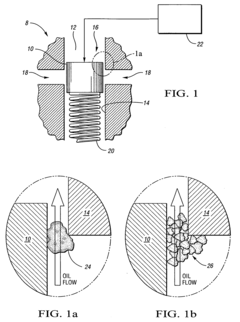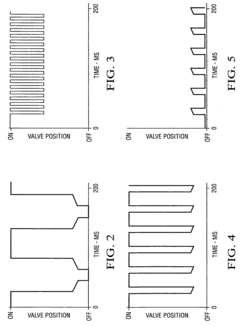Check Valves With Self-Cleaning Mechanisms
Technology Background And Goals
By examining the historical trajectory, this section will establish a solid foundation for understanding the current state and future potential of self-cleaning check valve technology. It will highlight the critical challenges and breakthroughs that have propelled the field forward, setting the stage for subsequent sections that will explore market demands, technological solutions, and potential innovation pathways.
Check Valves Market Demand Analysis
- Market Size and Growth
The global check valve market is expected to witness significant growth, driven by increasing demand from industries like oil and gas, water and wastewater treatment, and chemical processing. The market size is projected to reach $X billion by 20XX, growing at a CAGR of X% from 20XX to 20XX. - Key Application Areas
Check valves with self-cleaning mechanisms find widespread applications in industries where fluid flow needs to be regulated while preventing backflow and accumulation of debris or sediments. Major application areas include:- Oil and gas production and transportation
- Water and wastewater treatment plants
- Chemical and petrochemical processing
- Power generation facilities
- Food and beverage processing
- Market Drivers
- Stringent environmental regulations and emphasis on efficient fluid management
- Increasing demand for reliable and low-maintenance valve systems
- Expansion of industries like oil and gas, water treatment, and chemical processing
- Adoption of advanced technologies to improve operational efficiency and reduce maintenance costs
- Regional Trends
The Asia-Pacific region is expected to witness the highest growth rate in the check valve market, driven by rapid industrialization and infrastructure development in countries like China and India. North America and Europe also hold significant market shares due to the presence of established industries and stringent regulations.
Technology Status And Challenges
- Valve Clogging Issues
Clogging is a major issue for check valves, leading to reduced flow, increased pressure drop, and potential valve failure. Causes include debris buildup, scaling, and corrosion. - Existing Solutions
Current solutions involve manual cleaning, flushing systems, or specialized valve designs with features like self-cleaning mechanisms or anti-clogging materials. - Technical Challenges
Challenges include developing effective self-cleaning mechanisms, improving material resistance to clogging, and optimizing valve designs for specific applications and operating conditions. - Geographic Distribution
Clogging issues are prevalent in industries like water treatment, oil and gas, and chemical processing, across various regions with varying environmental and operational conditions.
Current Technical Solutions
01 Backflow-based Self-Cleaning
These mechanisms utilize backflow or reverse flow to dislodge and remove debris or contaminants that may have accumulated in the check valve, either by creating a temporary backflow condition or incorporating a dedicated backflow channel to flush out the valve.- Backflow-based Self-Cleaning: These mechanisms utilize backflow or reverse flow to dislodge and remove debris or contaminants accumulated in the check valve, either by creating a temporary backflow condition or incorporating a dedicated backflow channel to flush out the valve interior.
- Mechanical Agitation Self-Cleaning: These mechanisms employ mechanical agitation or vibration to dislodge and remove debris from the check valve, using movable components or external devices that induce vibrations or oscillations to shake off accumulated contaminants.
- Fluid Flow Pattern Self-Cleaning: These mechanisms utilize specific fluid flow patterns or vortices to prevent the accumulation of debris or contaminants in the check valve, involving strategically designed flow channels or valve geometries that create turbulent or swirling flow patterns to keep the valve interior clear.
- External Cleaning Device Self-Cleaning: These mechanisms incorporate external cleaning devices or systems that periodically clean the check valve, such as brushes, scrapers, or high-pressure fluid jets that are activated to remove accumulated debris from the valve interior.
- Valve Design Modification Self-Cleaning: These mechanisms involve modifications to the check valve design itself, such as incorporating specific valve seat geometries, valve trim designs, or material selections that reduce the accumulation of debris or facilitate easier cleaning.
02 Mechanical Agitation Self-Cleaning
These mechanisms employ mechanical agitation or vibration to dislodge and remove debris from the check valve, using movable components or external devices that create a shaking or vibrating motion to break up and clear any accumulated contaminants.Expand Specific Solutions03 Fluid Flow Pattern Self-Cleaning
These mechanisms utilize specific fluid flow patterns or vortices to prevent the accumulation of debris or to dislodge any contaminants that may have settled in the check valve, involving strategically designed flow channels or vortex generators.Expand Specific Solutions04 External Cleaning Device Self-Cleaning
These mechanisms involve the use of external cleaning devices or systems that can be periodically activated to clean the check valve, such as brushes, scrapers, or high-pressure fluid jets that can remove any accumulated debris.Expand Specific Solutions05 Valve Design Modification Self-Cleaning
These mechanisms involve modifications to the check valve design itself, such as incorporating specific surface textures or coatings that prevent the accumulation of debris, or using materials or geometries that facilitate the shedding of contaminants.Expand Specific Solutions
Technology Main Player Analysis
Halkey-Roberts Corp.
Proserv Gilmore Valve LLC
Key Technology Interpretation
- The valve assembly can automatically clean itself by cycling or shaking in response to predefined parameters like vehicle mileage or time.
- The valve cleaning frequency and duration can be adjusted based on various factors like vehicle mileage, shift density, or valve stroke time.
- The self-cleaning mechanism helps prevent valve sticking and improves overall valve performance by reducing friction and debris buildup.
Check Valves Self-Cleaning Mechanisms Economic Analysis
Check valves with self-cleaning mechanisms have the potential to significantly reduce maintenance costs and downtime in various industrial applications. The market demand for such valves is driven by the need for reliable and efficient fluid control systems in sectors like oil and gas, chemical processing, power generation, and water treatment.
The global market for industrial valves is expected to reach $92.5 billion by 2027, growing at a CAGR of 4.2% from 2020 to 2027 (Allied Market Research). Within this market, the demand for check valves with self-cleaning mechanisms is likely to rise due to their ability to minimize clogging and fouling, which can lead to frequent maintenance and unplanned shutdowns.
Key factors driving the adoption of self-cleaning check valves include:
1. Operational cost savings: By reducing the need for manual cleaning and maintenance, these valves can significantly lower operational costs, particularly in harsh or remote environments.
2. Increased uptime and productivity: Self-cleaning mechanisms help minimize unplanned shutdowns and downtime, leading to higher productivity and efficiency in industrial processes.
3. Environmental and safety benefits: Reduced manual intervention for cleaning and maintenance minimizes potential exposure to hazardous substances and improves overall safety.
However, the initial investment costs for self-cleaning check valves may be higher than conventional valves, which could be a barrier for some industries or applications. Nonetheless, the long-term cost savings and operational benefits are expected to drive adoption, especially in industries with stringent uptime and safety requirements.
It is crucial for manufacturers to conduct comprehensive cost-benefit analyses and Return on Investment (ROI) calculations to demonstrate the economic advantages of self-cleaning check valves over their lifecycle. Additionally, ongoing research and development efforts to improve the reliability, efficiency, and cost-effectiveness of these valves will further contribute to their market growth and adoption.
Check Valves Self-Cleaning Mechanisms Environmental Impact
Environmental impact is a critical consideration when evaluating any new technology or product. In the case of check valves with self-cleaning mechanisms, it is essential to assess their potential effects on the environment throughout their lifecycle, from raw material extraction and manufacturing processes to operational use and eventual disposal or recycling.
During the manufacturing phase, the production processes and materials used in constructing these valves should be examined for their environmental footprint. This includes evaluating the energy consumption, greenhouse gas emissions, and the generation of hazardous waste or byproducts associated with the manufacturing facilities.
The operational use of these self-cleaning check valves may have implications for water and energy conservation. By reducing the buildup of debris and minimizing the need for manual cleaning or maintenance, these valves could potentially lead to more efficient fluid flow and reduced energy consumption in various industrial and municipal applications.
Additionally, it is crucial to consider the environmental impact of the materials used in the construction of these valves. Materials such as metals, plastics, or composites may have different levels of recyclability or biodegradability, influencing their overall environmental impact at the end of their service life.
Furthermore, the self-cleaning mechanisms employed in these valves should be evaluated for their potential to release any harmful substances or byproducts into the environment during operation. Factors such as chemical treatments, abrasive materials, or ultrasonic cleaning methods may have implications for water quality or air pollution if not properly controlled or contained.
Overall, a comprehensive life cycle assessment (LCA) should be conducted to quantify the environmental impacts associated with the production, use, and disposal of these self-cleaning check valves. This assessment should consider factors such as energy consumption, greenhouse gas emissions, water usage, and waste generation throughout the entire product lifecycle. By identifying and addressing potential environmental concerns, manufacturers and users can work towards minimizing the ecological footprint of these innovative valve solutions.



